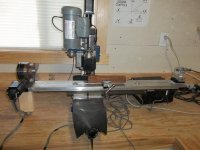Hello,
I have no CNC knowledge but have been thinking about taking some classes. I have been looking at this machine and was wondering if it would be good for cue building or at this price range is there something else that would be a better choice?
Any advice would be greatly appreciated.
http://www.microproto.com/MMDSLS.htm
I have no CNC knowledge but have been thinking about taking some classes. I have been looking at this machine and was wondering if it would be good for cue building or at this price range is there something else that would be a better choice?
Any advice would be greatly appreciated.
http://www.microproto.com/MMDSLS.htm
